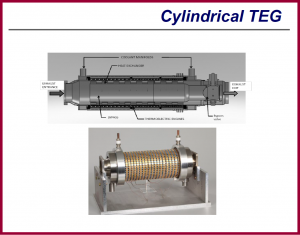Advanced work is now well underway to convert automotive exhaust gas waste heat into electricity. Since roughly 60% of the energy produced by a gasoline engine is lost through heat, this is one area where substantial improvements in efficiency are possible. About 33% of the heat generated by combustion goes out the exhaust system doing no usable work.
Not surprisingly, given increasingly stringent fuel economy and CO2 regulations, research is being done to see how exhaust waste heat can be used. One promising area – generating electricity from the heatis seeing a comapny called Gentherm working with is Tenneco. The current project calls for Gentherm to supply modular, cylindrical-shaped thermoelectric cartridges that convert waste heat from the exhaust into electricity. Tenneco then integrates the cartridges inside a thermoelectric generator or TEG that includes a unique heat exchanger.
In 2004, Amerigon, now renamed, as badly, Gentherm began developing thermoelectric waste energy systems for passenger vehicles for the U.S. Department of Energy (DOE) Freedom Car Office through taxpayer grants of $2 million. After delivering working prototypes to BMW and Ford, the TEG – for thermal electricity generation – technology was proven by producing a “significant amount of electricity.” (Amerigon Gets Taxpayer Funds for Thermo Energy Recovery)
Gentherm was then awarded an additional $8 million grant from the DOE to continue to lead development of the new energy recovery system for commercialization “on the scale needed to positively impact the reduction of greenhouse gasses,” according to the DOE grant. Gentherm is known to be working with Ford and BMW of North America, and the latest project is due for completion in 2015. No production applications have been announced by either of the automakers, and a Chrysler 300 fitted with a TEG was seen by AutoInformed.
Gentherm is perhaps best known for its Climate Control Seat System that uses thermoelectric technology to actively heat and cool seats in vehicles made by many automotive manufacturers. That technology consumes energy of course. Cutting down on energy use has a big future.



Interesting bit of technology. Energy Harvesting is a growing market, mostly to feed small electronics with energy that is independent from outside sources. Everything from Vibration and RF Energy is a viable source of free energy, but in reasonably small quantities. This Waste Heat solution seems best for Fleet vehicles like buses and long haul trucks, the average car trip will be far too short and cost more in service than the power it will generate.